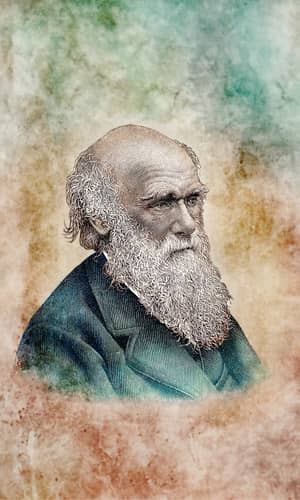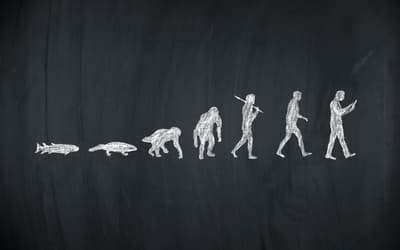The views expressed in this paper are those of the writer(s) and are not necessarily those of the ARJ Editor or Answers in Genesis.
Abstract
Darwin reasoned that the standards of human beauty would vary considerably in different parts of the world because these judgments evolved as a result of local sexual selection pressures. However, in contrast to Darwin’s prediction, and that of other evolutionists, recent research has demonstrated that judgments of human beauty are remarkably similar regardless of race, sex, or culture. This supports the conclusion that standards of human beauty were hard wired by our Creator in Adam and Eve. Most of the research in this area focuses on anatomical features of the face, but standards of beauty for other bodily features are likewise very uniform regardless of race, sex, or culture.
Keywords: culture problems in evolution, Darwin, human beauty, human evolution, sexual selection
“Sexual selection” was one of the major arguments Darwin used to explain the origin of physical traits that lacked any obvious advantage in the competition for survival, including humans. Sexual selection involves the choices that members of a species make when choosing a mate. Furthermore, “sexual selection was of great strategic importance to Darwin because it explained things that natural selection could not and offered a naturalistic, as opposed to divine, account of beauty and its perception”(Richards 2017, 2). Specific choices by mates, such as birds adorned with bright colors, cause those traits to become more common in the population. The result, Darwin predicted, would be that brightly colored birds would mate more frequently and, consequently, produce more offspring than animals lacking bright plumage. In time, the bright-colored birds would become numerically dominant. Eventually, Darwin predicted, the dull colored birds would become rare and, in many cases, extinct (Bergman 2021). As Leroi observed, sexual selection “is a pleasing but difficult-to-prove hypothesis” (Leroi 2003, 267).
Darwin believed that sexual selection also answers questions such as “how did human faces change from the chimp-australopithecine face to the modern human face?” It is assumed that males preferred females that possessed certain facial features. Consequently, the human ancestor-chimp face evolved into the modern human face. The result is that chimpanzee and human faces now differ greatly in their underlying anatomy (Huber 1931). Specifically, chimpanzees have more prognathic faces with an elongated mouth, a lower forehead with more substantial brows, a flatter nasal area, significantly less check fat, and lack a bony chin compared to humans (Vick 2007). As a result, Darwin reasoned that cultural determinations of beauty would vary greatly in different parts of the world because sexual selection depends on the local culture, which would be very different between different people groups. For sexual selection theory to be consistent, our human chimp ancestors would slowly have disappeared as more human-like men mated with more human-like females.
Note Darwin’s reasoning, which also reflects his evolutionary beliefs, in the following quote: “evolution by mate choice produces profoundly different patterns of variation in nature. . . . [thus producing] independent ‘standards of beauty’” (Prum 2017, 10). Darwin concluded that judgment about which “human faces are beautiful, at least as far as female beauty is concerned . . . differs widely in the different races of man, as will hereafter be shown, and is not quite the same even in the different nations of the same race. Judging from the hideous ornaments and the equally hideous music admired by most savages, it might be urged that their aesthetic faculty was not so highly developed as in certain animals . . .” (Darwin 1871, 62).
Darwin added that sexual selection “played a critical role in [the] shaping of the human species” from a hairy quadruped to a modern biped human (Prum 2017, 22). Evolutionary biologist Armand Leroi in his lifetime study of Darwin concluded that Darwin unequivocally believed that judgements of physical beauty are “not universal, but rather particular. Different people in different parts of the world each have their own standard of beauty.” (Leroi 2003, 349)
Field research evaluating Darwin’s sexual selection of beauty beliefs has concluded “that Darwin was wrong” (Grammer 2003, 401). Professor Grammer detailed that the
main problem with Darwin’s approach was that he relied extensively on correspondence with missionaries in order to obtain information about the beauty standards in different human cultures. These data often were collected by persons with a British beauty standard and thus do not give evidence for a cross-cultural standard of beauty. Contrary to most other fields of evolutionary biology, . . . . Darwin actually stagnated studies of human beauty for a century by the claims about lack of general principles. It is only recently that features of human facial and bodily beauty have been cross-culturally validated. . . . Darwin’s claims about the lack of a general beauty standard were at odds with the sheer magnitude of the beauty industry. (Grammer 2003, 387)
Ironically, “Darwin was one of the first to discuss the possible universality of facial attractiveness across cultures by noting in 1871 that explorers had remarked to him that indigenous people around the world shared similar standards of beauty. There is some evidence that worldwide . . . people agree to a large extent on which faces are considered beautiful” (Rumsey and Harcourt 2005, 4). However, Darwin evidently chose to ignore this information and relied instead on missionary reports possibly because the missionary reports agreed with his evolutionary conclusions.
A major problem with the sexual selection theory is that “Predominant mate choice theories assume preferences are determined solely by genetic inheritance, an assumption still lacking widespread support” (DuVal 2023). If mate selection causes a mate to evolve to be more like the mate’s perception of beauty, where did the perception of beauty in the selector come from in the first place? Creationists answer is that it was hard wired in the creation of man; consequently, it was similar throughout the world. The reason is because the standards of beauty hard wired in Adam would be the same in all men and women throughout history. Evolutionist Prum’s answer is coevolution and the standard would vary greatly through history (Prum 2017, 26). Darwin argued that, as the female selectors evolved toward becoming more attractive to males with less hair, males correspondingly evolved to have less body hair. Consequently, hairy apes became, in the words of Desmond Morris, naked apes (Morris, 1999).
This circular argument requires a mechanism to cause the female selector to coevolve the criteria to desire mates with less hair. On this point the edifice of sexual selection becomes especially troublesome. This problem with sexual selection involves the fact that “mismatches between theoretical and empirical patterns demonstrate that mate-choice models still lack critical components of the process by which preferences arise” (DuVal et al. 2023). In other words, the specific mechanism of how sexual selection functions is not supported either by theory or by field data.
When a female is chosen by a male, it is often unclear why this specific individual was favored. One problem is that phenotypic variation is complex, and often multimodal. With humans, the attraction could be the female’s facial features, smile, intelligence, eye and hair color, voice, academic achievements, personality, or conversational skills. Likely, it was a combination of these factors, but it is very unlikely that each of these factors made equal contributions.
One important factor which complicates sexual selection is that men are often attracted to women that are in many ways like their mother, and women are often attracted to men that remind them in many ways of their father (Masoom 2022). Yet another factor that females consider in a potential mate is whether they believe the man will make a good father (Ruger 2019). Again, which factors are more important, and which are of only minor importance, has been a major unsolved problem of the sexual selection theory.
Contrasts Between Theory and Field Data
As a young man, I worked as a commercial photographer. For most pictures, we hired a female model to stand next to the open door of a car or other items we were photographing. Advertisers knew from extensive market research that attractive females draw both males and females to the advertisement, thus selecting the right female model was critical in successful advertising. All models were attractive, supporting the survey findings references above, but some were better at drawing attention to the product.
In choosing a model we also knew what traits were desirable for our advertisements to attract the specific class of desired customers. These traits were very specific for print modeling (catalog or editorial, in contrast to catwalk and/or television modeling). Facial traits were critically important, and had to include such attributes as facial symmetry, high cheekbones, large eyes, perfect teeth (no gaps, even small ones, no crooked or chipped teeth), defined lips, a Nubian nose (one characterized by a perfectly straight bridge that lacks curves or bends), and a smooth skin free of visible blemishes. All of these factors also affect mate choice (Dixson 2009).
Universal Perceptions of Beauty
Widespread agreement of beauty exists among both males and females and even among different people groups. One technique in evaluating beauty standards is to have subjects rate the attractiveness of young adults, from the most to the least attractive, based on photographs of the face. In one test, pictures were rated of white males, and in another test, white females. The test with 53 male subjects produced a 92% agreement score among the raters. Likewise, for the female subjects a similar score of 94% was observed. In another test, pictures of young black males and young black females were rated by both whites and blacks. Again, a high (87%) level of agreement was demonstrated regardless of the rater’s race or sex. In another segregated test, blacks, given the same set of black males and females to rate, demonstrated a 95% agreement score. There appears to be widespread agreement of beauty scores among both males and females and among different people groups. And, although all of the subjects in the pictures were Westerners, as were all of the raters, replication of the study in different cultures tended to produce very similar results (Rumsey and Harcourt 2005). This is in contrast to the long held belief, and Darwin’s conclusions, that different cultures use very different criteria when judging physical attractiveness. Furthermore
recent work, including a meta-analysis of facial attractiveness preferences, found high consistency between people’s judgements of facial attractiveness, . . . leading to the conclusion that ‘‘raters agree about who is and is not attractive, both within and across cultures.” (Coetzee 2014, 1)
In 1993, anthropologists, Jones and Hill, traveled to two relatively isolated tribes in Venezuela and Paraguay. Previously, the tribe members had little contact with people outside their own villages. They had no access to TV and had never seen images of people from other parts of the world. After being shown a set of photos of people from various cultures, they were asked to rate them for beauty. Their judgments were then compared with ratings of the same photos by people from Russia, Brazil, and the USA. People in all five countries chose female faces with very similar features, including a delicate jaw and chin and large eyes (Jones and Hill 1993). Other studies confirm the observation that delicate jaws and chins, smooth skin, large eyes, and plump lips were very desirable traits (Kemp 2004).
Other research on facial preferences consistently found widespread agreement among raters (Prum 2017), and also found “high agreement in facial attractiveness preferences within and across cultures” (Coetzee et al. 2013). Specifically, the research found “significant agreement between White Scottish and Black South African observers’ attractiveness judgements, providing further evidence of strong cross-cultural agreement in facial attractiveness preferences . . . . [with] higher cross-cultural agreement for female, compared to male faces, albeit not significantly higher” (Coetzee et al. 2013). Additionally, a study of ancient Egyptian persons depicted in paintings and statues found that the same traits were valued then as we value now.
In summary, the consensus on which females are considered to be attractive is very high in four different cultures (Asia, Hispanic, Black, and White women rated by males from all cultures).” (Grammer et al. 2003, 388). Furthermore, it appears that judgments of facial beauty begin very early in life: “Three-month-old children gaze longer at attractive faces than unattractive faces.” (Grammer 2003, 388). These differences are believed to be innate, thus inborn, which creationists would interpret as having been put in place by the Creator.
Ideal Beauty is Rare
When working with modeling agencies, I learned that few women and men have all, or even most, of these preferred traits. For example, very few young women who applied for modeling work met the standard. Even Darwin concluded that physical beauty in humans as defined by universal standards is rare (Grammer 2003, 349). A problem with sexual selection is, few people today fit into the mold of what humans view as attractive after what evolutionists claim has been over 200,000 years of sexual selection.
Average Persons Are Most Attractive
One computer research study provided evidence that a large number of faces, when computer averaged, produce a face that is widely regarded as relatively attractive. The fact is that
Scientists and philosophers have searched for centuries for a parsimonious answer to the question of what constitutes beauty. We . . . . predicted that faces representing the average value of the population would be consistently judged as attractive. To evaluate this hypothesis, we digitized samples of male and female faces, mathematically averaged them, and had adults judge the attractiveness of both the individual faces and the computer-generated composite images. Both male (three samples) and female (three samples) composite faces were judged as more attractive than almost all the individual faces comprising the composites. A strong linear trend also revealed that the composite faces became more attractive as more faces were entered. (Langlois and Roggman 1990)
These data show that, when averaged, facial characteristics close to the population mean are considered attractive by raters. Although computer-averaged faces were deemed the most attractive, certain atypical characteristics can enhance facial attractiveness (Alley and Cunningham 1991). One common view held is that, from an evolutionary perspective, the most desirable mate for a male
is a female with high reproductive capacity; that is, a young woman. Hence, males can be expected to prefer relatively youthful, rather than average [attractive], female facial characteristics. . . . For a female, the ideal mate is a male who can compete successfully for resources and provide protection for his offspring. Women may be expected to prefer extremes of detectable facial characteristics to the extent that these reflect males’ strength, health, or ability to provide resources or protection for their offspring. Thus the appearance of robust health, clear skin, and strong muscles in a male is likely to be more attractive to females than the appearance of [computer averaged] . . . health, skin, and muscles. (Alley and Cunningham 1991)
The research reviewed above illustrates that this evolutionary view is less viable than was once believed. International surveys of mate preferences reveal that women prioritize financial prospects, but men emphasize physical attractiveness (Whyte et al., 2021). One problem with physical attraction research is that, in the real world, very few people actually select a mate with all of the desired characteristics being equally selected. In reality, most women feel they are forced to settle for a mate (Gottlieb 2011). As explained by Professor Masoom “despite explicit preferences for a higher quality partner, compromise or acceptance of a mate of lesser quality than other potential mates may occur during mate selection” (Masoom 2022). These problems, and others, are why three main theories exist about how sexual selection actually works, all of them problematic. One of the most important factors in selecting a mate has little to do with sexual selection or even attraction, namely propinquity: “Propinquity, or distance in space [that is, proximity], is one of the most influential factors in narrowing the pool of potential mates” (Hazan and Campa 2013).
Most of the factors that are part of the “attraction package” apply more to evaluating sexual selection in humans rather than in animals. An advantage in researching sexual selection in humans is that we can ask them why they selected a certain person as a mate. For an animal, we have to guess or assume. One exception is that we can measure both propinquity (location proximity and geographical closeness) and the pool of potential mates, both important factors in mate selection. These, and many similar factors, all greatly complicate Darwin’s over-simplified largely speculative sexual selection theory.
Summary
Darwin’s sexual selection theory superficially appears logical when the example used is traits such as song birds’ plumage, (colorful, in contrast to dull). In real life, however, when using more realistic examples, the theory breaks down. Although sexual selection may have a minor role in affecting the frequency of certain traits, it has little relevance to the problem of explaining the origin of the trait, such as the origin of feather coloration. Evolution explains variations in color exist in most animals, and certain colors are preferred by mates. Thus they become more common. This does not answer why mates have certain preferences. Nor does it explain the origin of the feather coloration or other trait. It can only describe the changes in the frequency of the trait. Evolutionists appeal to mutations for the explanation of the origin of the trait which, of course, also fails because the vast number of mutations that occur are near-neutral or deleterious. The research supports the conclusion that these values were not the result of sexual selection. Rather, Adam and Eve were hard wired with the values of beauty in their brains and likewise genetically created the trait details and hard wired the preferences for the color.
References
Alley, Thomas R., and Michael R. Cunningham. 1991. “Averaged Faces Are Attractive, But Very Attractive Faces Are Not Average.” Psychological Science 2, no. 2 (March): 123–125.
Bergman, Jerry. 2021. “Sexual Selection Fails to Explain Beauty.” Creation Evolution Headlines, March 15. https://crev.info/2021/03/sexual-selection-fails-to-explain-beauty/.
Coetzee, Vinet, Jaco M. Greeff, Ian D. Stephen, and David I. Perrett. 2013. “Cross-Cultural Agreement in Facial Attractiveness Preferences: The Role of Ethnicity and Gender.” PLoS ONE 9, no. 7 (July): e99629. doi:10.1371/journal.pone.0099629.
Darwin, Charles. 1871. The Descent of Man, and Selection in Relation to Sex. London, England: John Murray.
Dixson, Alan F. 2009. Sexual Selection and the Origins of Human Mating Systems. New York, New York: Oxford University Press.
DuVal, Emily, Courtney L. Fitzpatrick, Elizabeth A. Hobson, and Maria R. Servedio. 2023. “Inferred Attractiveness: A Generalized Mechanism for Sexual Selection That Can Maintain Variation in Traits and Preferences Over Time.” PLoS Biology 21, no. 10 (October): e3002269. https://doi.org/10.1371/journal.pbio.3002269.
Gottlieb, Lori. 2011. Marry Him: The Case for Settling for Mr. Good Enough. New York, New York: E. P. Dutton.
Grammer, Karl, Bernard Fink, Anders P. Møller, and Randy Thornhill. 2003. “Darwinian Aesthetics: Sexual Selection and the Biology of Beauty.” Biological Reviews 78, no. 3 (August): 385–407.
Hazan, Cindy, and Mary Campa. eds. 2013. Human Bonding: The Science of Affectional Ties. New York, New York: Guilford Press.
Huber, Ernst 1931. Evolution of Facial Musculature and Facial Expression. Oxford, England: Oxford University Press.
Jones, Doug, and Kim Hill. 1993. “Criteria of Facial Attractiveness in Five Populations.” Human Nature 4, no. 3 (September): 271–296.
Kemp, Sandra. 2004. Future Face: Image , Identity , Innovation. London, United Kingdom: Profile Books.
Langlois, Judith H., and Lori A. Roggman. 1990. “Attractive Faces Are Only Average.” Psychological Science 1, no. 2 (March): 115–121.
Langlois, Judith H., Lisa Kalakanis, Adam J. Rubenstein, Andrea Larson, Monica Hallam, and Monica Smoot. 2000. “Maxims or Myths of Beauty? A Meta-Analytic and Theoretical Review.” Psychological Bulletin 126, no. 3 (May): 390–423.
Leroi, Armand Marie 2003. Mutants: On Genetic Variety and the Human Body. New York, New York: Viking.
Masoom, Muhammad Rehan. 2022. “What Potential Traits Do Adolescents and Early Adults Look For in Mate Preferences?” Heliyon 8, no. 12 (December): e12169.
Morris, Desmond. 1999. The Naked Ape: A Zoologist’s Study of the Human Animal. New York, New York: Delta.
Prum, Richard. 2017. The Evolution of Beauty. How Darwin’s Forgotten Theory of Mate Choice Shapes the Animal World—And Us. New York, New York: Doubleday.
Richards, Evelleen. 2017. Darwin and the Making of Sexual Selection. Chicago: University of Chicago Press.
Ruger, Jack. 2019. Would He Be a Good Father?—10 Hidden Qualities Women Want in a Man. Independently published.
Rumsey, Nichola, and Diana Harcourt. 2005. The Psychology of Appearance. New York, New York: Open University Press.
Vick, Sarah-Jane, Bridget M. Waller, Lisa A. Parr, Marcia C. Smith Pasqualini and Kim A. Bard. 2007. “A Cross-Species Comparison of Facial Morphology and Movement In Humans and Chimpanzees Using the Facial Action Coding System.” Journal of Nonverbal Behavior 31, no. 1 (March): 1–20.
Whyte, Stephen, Robert C. Brooks, Ho Fai Chan, and Benno Torgler. 2021. “Sex Differences in Sexual Attraction For Aesthetics, Resources and Personality Across Age.” PLoS One 16, no. 5: e0250151.











